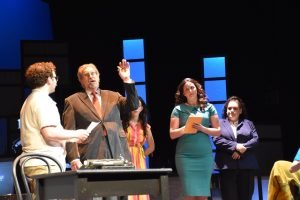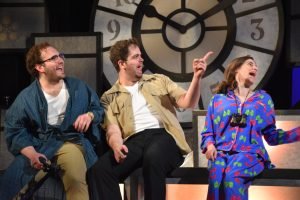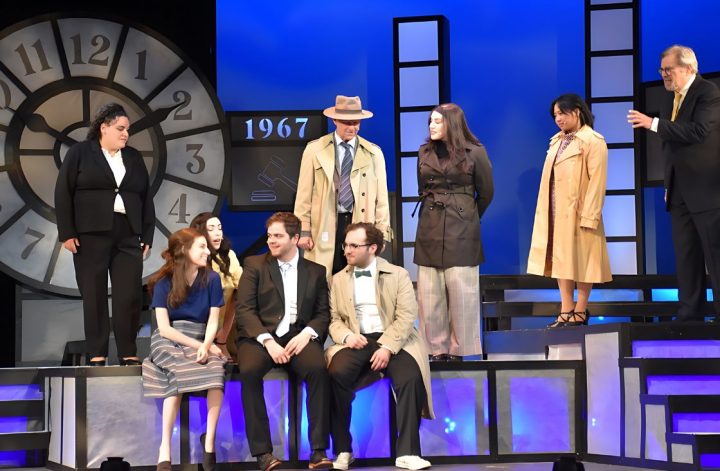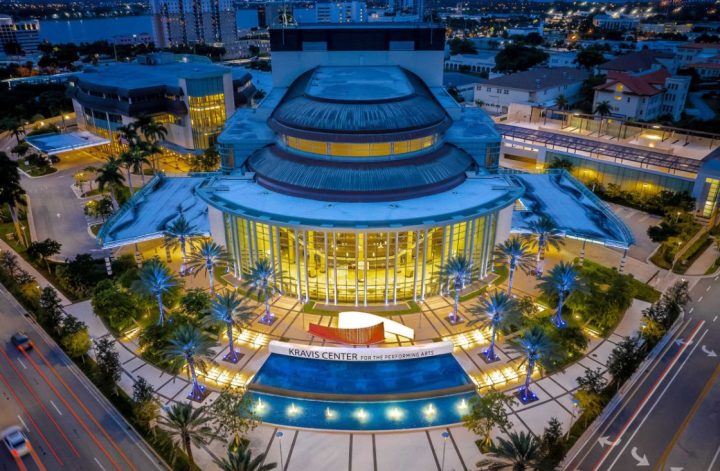If timing is everything, MERRILY WE ROLL ALONG’s time is NOW. The latest iteration of Stephen Sondheim’s “most autobiographical musical” is currently experiencing enthusiastic crowds and rave reviews on Broadway. Labeled “a revelatory and intoxicating revival” by “The Washington Post” and considered “one of the best musicals of the theatre season!” by “The New York Post.”
But there’s no need to rush to get Broadway tickets and a flight up north. Because our very own beautiful, affordable, and sight-line-blessed Delray Beach Playhouse is presenting this hot new Sondheim (music and lyrics) and George Furth (book) revival – with then director Hal Prince, the same team responsible for landmark “Company” – now through April 7.
Based on George S. Kaufman and Moss Hart’s 1934 play, Sondheim and Furth adapted the original characters’ professions to fit the ones they know best (their own) while keeping the playwrights’ unique, turning-back-the-hands-of-time with each scene, directive. We’re informed, and reassured, about this aspect by a delightfully witty young man who greets us from the stage, introducing himself only as “the voice you normally hear asking you to silence your cellphones.” We also learn that the company is celebrating its 77th continuous season (wow!). He adds that today’s performance will take two-hours-and-30 minutes with one 15-minute intermission and … apparently most important: Not to worry about following the musical’s reverse-order chronology.
Each scene change is amply telegraphed by a musical interlude, with the new landing date clearly lit-up on stage. I’ll add, there’s a large, bright, old-fashioned clock, with hands, hanging stage right, that always spins backward to alert you to what’s coming, along with a reverse countdown in years till we arrive at the proper date. Not to mention, opening each new scene with broadcast and popular song highlights of the year (a nostalgic trip down memory lane on its own!) while the ensemble enters all decked out in the period’s coolest outfits and hairdos (thanks to costume designer Penny Williams). We travel back two decades, in all.

Photo Credit: Cindi Taylor
Starting with where our three main characters end up – at the cusp of middle age. Act One, Scene One: Bel Air, CA – 1976. The scene opens with an Overture by an uncredited live band that my eagle-eyed seatmate noticed playing, mostly hidden, in a back corner of the stage. They perform perfectly throughout the show under Aidan Quintana’s music direction. Here I might also mention the smooth scene changes under the expert guidance of director/technical director Andre Lancaster, and spot-on choreography by Liz DeBeer.
But what you immediately notice in the opening scene is the strikingly original (what I consider artist Mondrian-inspired), bold, geometric set design – thanks to scenic designer/artist Cindi Blank Taylor, enhanced by ongoing lighting adjustments by lighting designer Stevie Bleich.
Bit by bit the company arrives onstage, facing us and singing the musical’s namesake number that will appear several times – each time evoking a different reaction. What it evoked for me, especially in the second company song, “That Frank” – when a bunch of Hollywood bigwigs celebrate Frank Shepard’s (Bob Ruggles) latest popular film success – is the ground-breaking format of Sondheim and Furth’s earlier hit, “Company.” Wherein the entire ensemble (in this case, appearing in Frank’s luxe LA digs vs. Bobby’s living room) address the audience with their opinions of the musical’s main character. At this cocktail party celebration, the rich and famous unanimously sing Frank’s praises for having achieved the standard Hollywood dream of fame and fortune.
But Frank’s oldest friends – those who knew him “back when” and admired him as a composer and original musical-theater genius – feel he’s sold out completely. And while his life may appear glamorous, we quickly witness the inevitable cracks. The ire of movie star, Gussie (Rachel O’Hara) – whom he’d left his loving wife and child for – has now, herself, been aged out of a starring role in his latest film and replaced by younger starlet, Meg (Hailey McDonough). And just like she’d lured him from his wife years ago, she now accuses Frank of having found a new muse and lover in Meg. Hmm… What goes around, comes around, no?
We also meet Frank’s former partner, lyricist and playwright Charley (Chris Ombres) who’d married young and remained faithful to his wife, growing family, and creative process, till the end. He tends to serve as Frank’s conscience, and when he holds him accountable for producing run-of-the-mill products for mass consumption while neglecting his true gift on live TV in a later (timewise “earlier”) scene, “humiliated” Frank banishes his oldest friend and writing partner from his life. Still he can’t escape the sting of Charley’s words. When a guest in that initial scene (the one that sums up their middle-age milestones) mentions Charley’s Pulitzer-prize-winning play, he tenses up. And we realize that Frank would have preferred to be celebrated for his true talent in music than yet another successful, but run-of-the-mill, Hollywood production.
The third member of this “dreaming big in their early twenties” trio is writer Mary (Devra Seidel) who instantly recognizes Frank’s musical gift, is secretly in love with him and, while working on her novel for years while resorting to odd jobs to support herself (like being a theater critic and writing ad captions), has finally achieved publishing success.
For the umpteenth time, Frank tells her, “just wait till the next film,” one that won’t be formula driven for the masses. But she no longer believes him and drinks herself stupid, making a scene where she “toasts” Frank by loudly criticizing him, his guests, and their entire phony setup. It all falls apart for Frank when he admits the truth of Mary’s words to himself, and leaves second wife, Gussie (who then takes her anger out on poor Meg by splashing iodine in her eyes). What a Hollywood horror story!
With Mary’s disparagement of Frank’s fancy residence and achievements toppling his life like a house of cards, all the scenes that follow move back in time to reveal how he ever got there in the first place. Complemented by Mary and Charlie’s number, “Old Friends/Like it Was.” Perhaps what’s most surprising is when now-devastated Frank asks his former wife – the woman whose voice he’d chosen while casting for his very first musical back when he and Charlie were just starting out – if she still loves him. They’d soon married despite wariness by Beth’s middle-class parents (who aren’t exactly happy about a son-in-law without a real job and who, we later discover, also got their daughter pregnant with their son, Frank Jr. [Sagan Flantzbaum]).
An earlier poignant scene occurs on the rooftop of Frank and Charlie’s shabby, 110th Street, Manhattan apartment. As they share binoculars and gaze, transfixed, at Sputnik’s track, Charlie tells Frank, “You and I can change the world.” Frank’s response: “We’re the luckiest people… We can do anything. What a time to be alive!”
It’s only after we move forward in time to hear Beth’s song, now full of pathos and lost dreams (this is one more song that’s repeated with different nuances for different situations), do we fully appreciate her as a woman, mother and wife. When Elizabeth Robinson (as Beth) sings “Not a Day Goes By,” we all sit up and take notice. Storywise, if she hadn’t committed to what was then the traditional life of wife and mother, she could easily have been a star of stage and screen. I’m just glad Robinson was discovered for this role so that at least we, in the audience, can appreciate her immense vocal talent.
Rachel O’Hara also shines as Gussie. At times, literally. She opens Act II all decked out in a glamorous, sparkly gown for the “Act 2 Opening” number. And Devra Seidel’s Mary showcases her comedic side while also nailing some of the most emotionally wrought lines in the show. Always the woman behind the men, she’s the most sympathetic and sensitive character that may be too starry-eyed for her own good. Her unshakable ideals are on full display when the final songs of Act II bring them back to 1957 where she joins the company in celebrating “Our Time” and “Opening Doors.” Reawakening all the fresh-faced optimism of youth.

Photo Credit: Cindi Taylor





